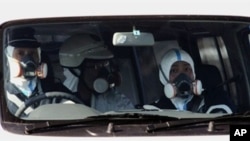Government officials say as many as 160 people may have been exposed to radiation in Fukushima Prefecture
Japan is struggling to keep nuclear power reactors under control. This comes as massive search and rescue efforts are underway in the northeastern part of the country following Japan's worst ever natural disaster.
Watch video of the explosion at the Fukushima nuclear plant
The official death toll is now over 1,000 with thousands more people unaccounted for and 300,000 Japanese evacuated from severely damaged communities following Friday earthquake and large tsunami.
Government officials early Sunday said as many as 160 people may have been exposed to radiation here in Fukushima Prefecture. That occurred following an explosion at the crippled number one plant of the Fukusihma nuclear power complex.
It apparently happened as the result of steps taken to try to prevent the reactor melting after the facility lost power as a result of the quake and tsunami. Plant operators initiated a desperate measure to cool the number one reactor using seawater and boric acid. Government officials say the containment vessel around the reactor's core is intact.
On Sunday, Japan's nuclear safety agency reported an emergency at a second reactor here. And there are domestic media reports that up to six reactors in all here in Fukushima Prefecture have lost their cooling function. Worries of meltdowns of reactors is now overshadowing the search and rescue efforts following the mega-quake and resulting tsunami that has devestated hundreds of kilometers of Japan's pacific northeastern coast.
Prime Minister Naoto Kan Saturday evening addressed Japan expressing hope that as he put it this disaster can somehow be survived. Besides helping the thousands of people injured and made homeless by the quake and tsunami, he said his top priority is the emergency with the damaged nuclear power plants here in Fukushima Pretecture.
|
Social Media: Disaster in Japan The Crisis Commons volunteer community has mobilized, and part of the effort is being coordinated by Japanese students at U.S. universities. The Red Cross has opened a page on causes.com to raise money for the victims of Friday's disaster in Japan. For more on how you can help, visit http://bit.ly/gD8At1 and Time Out Tokyo. Google has launched a service for people seeking to reconnect with those in the disaster area. The State Department tweeted: |
But the government is facing mounting criticism for delayed and partial information, generating skepticism about whether they are being totally forthcoming about the total extent of the crisis. A 20-kilometer evacuation zone has been established at the number one reactor and a 10 kilometer zone around a second one.
About 170,000 people have been moved out of the danger area. For most survivors however the immediate concern is not about potential radiation exposure. They are just trying to get by with life. More than one million households are expected to have been without water since the quake hit. Food supplies are dwindling, with many countryside communities cut off. They are surrounded by water or roads have been damaged.
The death toll remains unclear. Troops are finding hundreds of bodies along the beaches where tsunamis swept out to sea entire communities in neighboring Iwate and Miyagi prefectures. Other rescuers in helicopters are lifting people one by one who were stranded atop damaged buildings.
About 50,000 Japanese troops are to get assistance from foreign teams which are converging on northeastern Japan. More than 50 countries have offered help.





















